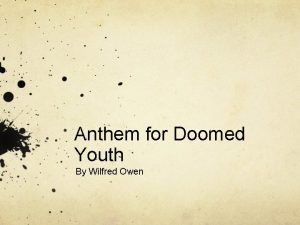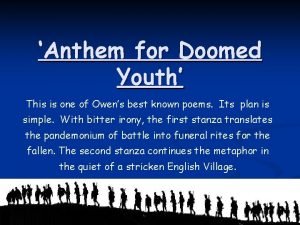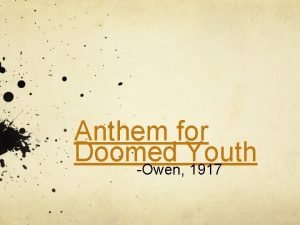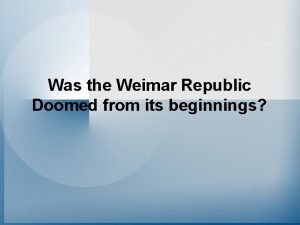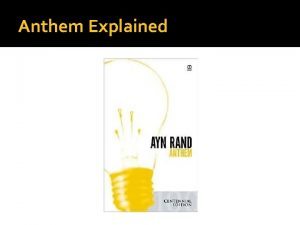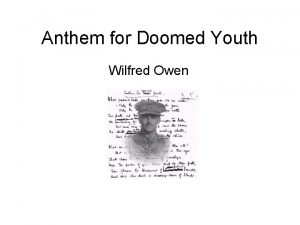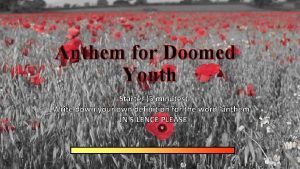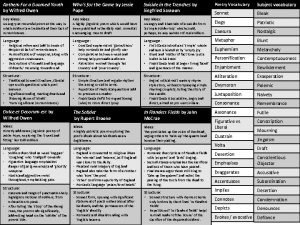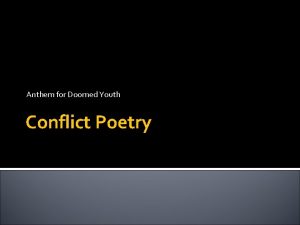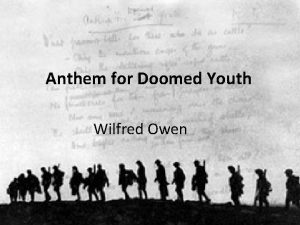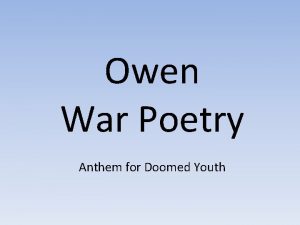Anthem for Doomed Youth Anthem for Doomed Youth















- Slides: 15

Anthem for Doomed Youth

Anthem for Doomed Youth What passing-bells for these who die as cattle? Only the monstrous anger of the guns. Only the stuttering rifles' rapid rattle Can patter out their hasty orisons. No mockeries now for them; no prayers nor bells; Nor any voice of mourning save the choirs, The shrill, demented choirs of wailing shells; And bugles calling for them from sad shires.

What candles may be held to speed them all? Not in the hands of boys but in their eyes Shall shine the holy glimmers of good-byes. The pallor of girls' brows shall be their pall; Their flowers the tenderness of patient minds, And each slow dusk a drawing-down of blinds.

What passing bells for these who die as cattle?

‘holy glimmers of good-byes’ ‘choirs’ ‘bugles calling’ ‘bells’ ‘sad shires’ ‘orisons’ Funeral / Death / ‘prayers’ ‘pall’ Mourning Images ‘mourning’ ‘flowers’ ‘candles’ ‘drawing down of blinds’

The first line of the poem describes the “Doomed Youth” dying “as cattle”. This description shows how awful war is. The description depicts multitudes of people being slaughtered and the nature of war to be full of mass deaths. The simile is showing how the soldiers are no more important than cattle which are lead to the slaughter without feeling. Owen gives the sonnet a powerful, negative connotation from the very beginning.



Two perspectives … The poem can be read in two parts that in the first octet Owen makes a catalogue of the sound of war, the weapons of destructions such as “guns” (line 2), “rifles” (line 3) and “shells” (line 7), which are linked to religious imagery such as “orisons” (line 4), “bells” (line 5), “prayers” (line 5). In contrast, in the second stanza the poem talks about the other side of a war: the families of those who die in the war. The rhyme scheme is ABAB CDCD EFFE /GG

Furthermore, Owen compares the events of war to traditional burial rituals and describes how those who die in war do not receive proper funerals. In the first stanza, Owen references the “monstrous anger of guns” to “passing-bells” and “rifles’ rapid rattle” to “hasty orisons”. Usually at funerals or ceremonies for the dead there are bells ringing and prayers being said, but Owen shows that in war there are only the sounds of guns being fired. In war, instead of honoring those who have fallen, more are being killed by the same weapons.

In the last stanza, Owen says “…but in their eyes shall shine the holy glimmers of good-byes. The pallor of girls’ brows shall be their pall”. Here Owen illustrates the families’ reactions to finding that their loved ones have died. The dead soldiers do not get to be honored by their family and friends, but all the family can do is grieve at the sorrowful news. Owen communicates how depressing war is by making an effective comparison that the readers can relate to.

Techniques … The poet depicts a tone that shows strong anger at the futility of war, because he is an anti-war poet. Wilfred Owen uses various literary devices through this poem. Firstly, the title itself has a significant use of assonance: “doomed youth”. The sound is intended to be long and melancholic. Secondly, repetition is used in the poem to make it seem monotonous. Finally, by using personification, Owen makes the enemies’ guns seem evil and monstrous. This can cause the reader to feel some of the emotions felt in the trenches.

Throughout the poem, Wilfred Owen uses a lot of comparisons, one of these is the simile between a typical funeral in a church and what would happen to a soldier killed in battle. For example, he compares the church bells with the noise of a gun-fire; the prayers with the rapid rifle fire; the choirs with the wailing of shells; the candles head by altar boys with the lights of the sky reflected in the dead eyes of the soldiers.

In conclusion After reading “Anthem for Doomed Youth” the reader’s entire perspective on war can be changed. Owen paints the horror of war in sensational manner that gets his message across strikingly well. Through his poem, Owen stirs up the heart and greatly influences the reader’s thoughts on war and those who fight in it.

http: //mural. uv. es/horpla/owen. html http: //es. wikipedia. org/wiki/Soneto#El_so neto_en_lengua_inglesa http: //www. warpoetry. co. uk. owena. htm Bibliography http: //www. 191418. co. uk/owen/anthem. htm
 Anthem for doomed youth by wilfred owen summary
Anthem for doomed youth by wilfred owen summary Anthem for doomed youth metaphor
Anthem for doomed youth metaphor Anthem for doomed youth assonance
Anthem for doomed youth assonance Great gatsby jeopardy
Great gatsby jeopardy Was the weimar republic doomed from the start
Was the weimar republic doomed from the start Sjungen poesi
Sjungen poesi Nyckelkompetenser för livslångt lärande
Nyckelkompetenser för livslångt lärande Romarriket tidslinje
Romarriket tidslinje Modell för handledningsprocess
Modell för handledningsprocess Borstål, egenskaper
Borstål, egenskaper Verktyg för automatisering av utbetalningar
Verktyg för automatisering av utbetalningar Vishnuiter
Vishnuiter Urban torhamn
Urban torhamn Vad står k.r.å.k.a.n för
Vad står k.r.å.k.a.n för Cellorov
Cellorov Boverket ka
Boverket ka
